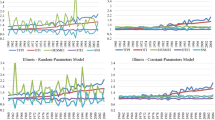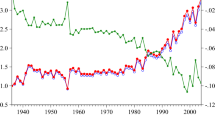Abstract
Using a stochastic frontier approach and a translog input distance function, this paper implements the input-oriented Malmquist productivity index to a sample of Greek aquaculture farms. It is decomposed into the effects of technical efficiency change, scale efficiency change, input-mix and, technical change, which is further attributed to neutral, output- and input-induced shifts of the frontier. Implementable expressions for the aforementioned components are obtained using a discrete changes-approach that is consistent with the usual discrete-form data. Empirical findings indicate that the productivity of the farms in the sample increased during the period 1995–1999 and it was shaped up primarily by the input mix-effect and technical change.
Similar content being viewed by others
Notes
Another difference between the non-parametric and the parametric approach, when the latter is based on stochastic frontiers, is that we are unable to estimate directly the Malmquist productivity index (Fuentes et al. 2001). Instead it should be computed indirectly through its components. The reason is that dealing with stochastic frontiers it is not possible to estimate the conditional expectation resulting in the predicted value of the distance function by combining the technology and the data of two different periods. This problem does not however arise when a deterministic frontier is employed.
The main disadvantages of the parametric approach are: first, a particular function form should be used to approximate the underlying production technology; second, it cannot function in cases with insufficient degrees of freedom; and third, it cannot provide precise estimates when there is extreme invariability in the data.
It is also possible to test whether technical change is implicit Hicks input and output biased or neutral.
A backward-looking approach is employed for the construction of the Malmquist productivity index by using period t technology as a reference point. Alternatively, either a forward-looking approach or a geometric mean of the two could have been used.
For technical change, as well as all other assembling parts of (1), values equal to one indicate no contribution to productivity changes.
Notice also that IB = 1 in the single-input case and OB = 1 in the single-output case.
Also notice that in the single-input case ME t I is identically equal to one.
Actually speaking this is the reciprocal of the input-oriented Malmquist productivity index used by Färe et al. (1992). It has however an appealing interpretation common to productivity literature since progress (regress) is depicted by values greater (less) than one.
The separability property implies that the productivity index can be interpreted as a relationship between an aggregated output and an aggregated input (Orea 2002). This property is related to a separability restriction on production technology, which in a parametric framework can be tested statistically.
A general concern with estimation of (13) is that the normalized inputs appearing, as regressors may not be exogenous. According to Coelli and Perelman (1999, 2000), however, the transformed input variables in (13) are measures of input mix, which are more likely to be exogenous in an expected profit maximization framework.
We have also experiment with Cuesta (2000) specification, which allows for firm-specific ξ parameters and it is thus more flexible than the Battese and Coelli (1992) model. However, most likely due to the short data panel at hand, we got extremely large estimated values for firm-specific time parameters which resulted in implausible high rate of technical efficiency changes at the individual firm level.
If instead we have used a deterministic frontier model then we can also compute (21) by using the fitted value of the input distance function based on (13) and (14), which is computationally less demanded. In this case and as long as the underlying technology exhibits global CRS, the Malmquist productivity index can be computed directly through (9).
Actually, the procedure used in the non-parametric approach cannot be applied because there is nothing to ensure that the CRS distance function necessarily envelops the corresponding VRS distance function when the parametric approach is used (Orea 2002).
Notice that for the computation of IB and ME, through (20) and (25) respectively, which involves different period quantities, the stochastic nature of the kth (numeraire) input should be taken into account. For this reason the quantity of the kth (numeraire) input is adjusted for the effect of the random noise by taking its predicted value using (14). In the computation of the all other TFP components we can replace a difference between the values of two distance functions by a difference between the values of two deterministic translog functions since input quantities are the same. We thank a referee who raised this point.
Non rejection of this hypothesis does not necessarily imply implicit Hicks output-neutral technical change. For this we should jointly test (28) and CRS.
CRS and joint input and output Hicks neutrality imply that the Malmquist productivity index satisfies the circular test, which means that both productivity and technical change are path independent (Fare and Grosskopf 1996, pp. 86–91).
In addition, the hypothesis of joint CRS and input and output Hicks neutrality is rejected at the 5% level of significance (see Table 3). This implies that the estimated Malmquist productivity index does not satisfy the circular test and consequently, both productivity and technical change are path dependent.
Since the separability between inputs and outputs in the estimated distance function is rejected at the 5% level of significance (see Table 3), the estimated productivity index cannot be interpreted as a relationship between an aggregated output and an aggregated input.
References
Aigner DJ, Lovell CAK, Schmidt P (1977) Formulation and estimation of stochastic frontier production function models. J Econom 6:21–37
Balk BM (2001) Scale efficiency and productivity change. J Prod Anal 15:159–183
Balk BM (2004) The many decompositions of productivity change. Unpublished manuscript
Battese GE, Coelli TJ (1992) Frontier production functions, technical efficiency and panel data: with application to paddy farmers in India. J Prod Anal 3:153–169
Caves DW, Christensen LR, Diewert WE (1982) The economic theory of index numbers and the measurement of input, output and productivity. Econometrica 50:1393–1414
Chambers RG, Fare R (1994) Hicks’ neutrality and trade biased growth: a taxonomy. J Econ Theory 64:554–567
Coelli TJ, Perelman S (1999) A comparison of parametric and non-parametric distance functions: with application to European railways. Eur J Oper Res 117:326–339
Coelli TJ, Perelman S (2000) Technical efficiency of European railways: a distance function approach. Appl Econ 32:1967–1976
Coelli TJ, Rao PDS, Battese GE (1998) An introduction to efficiency and productivity analysis. Kluwer, Boston
Cuesta RA (2000) A production model with firm-specific temporal variation in technical inefficiency: with application to Spanish dairy farms. J Prod Anal 13:139–158
Fare R, Grosskopf S (1996) Intertemporal production frontiers with dynamic DEA. Kluwer, Boston
Fare R, Grosskopf S, Roos P (1998) Malmquist productivity indexes: a survey of theory and practice. In: Fare R, Grosskopf S, Russell RR (eds) Index numbers: essays in honour of Sten Malmquist. Kluwer, Boston, pp 127–190
Färe R, Grosskopf S, Lindgren B, Roos P (1992) Productivity changes in Swedish pharmacies 1980–1989: a non-parametric Malmquist approach. J Prod Anal 3:85–102
Färe R, Grifell-Tatjé E, Grosskopf S, Lovell CAK (1997) Biased technical change and the Malmquist productivity index. Scand J Econ 99:119–127
Fuentes HJ, Grifell-Tatjé E, Perelman S (2001) A parametric distance function approach for Malmiquist productivity index estimation. J Prod Anal 15:79–94
Grifell-Tatje E, Lovell CAK (1997) A DEA-based analysis of productivity change and intertemporal managerial performance. Ann Oper Res 73:177–189
Grifell-Tatje E, Lovell CAK (1999) A generalized Malmquist productivity index. Top Sociedad Espanola de Estadistica e Investigacion Operativa 7:81–101
Grosskopf S (2003) Some remarks on productivity and its decompositions. J Prod Anal 20:459–474
Karagiannis G, Katranidis SD, Tzouvelekas V (2000) Measuring technical, allocative and cost efficiencies of seabass and seabream farms in Greece. Aquac Econ Manage 4:191–207
Karagiannis G, Katranidis SD, Tzouvelekas V (2002) Measuring and attributing technical inefficiencies of seabass and seabream production in Greece. Appl Econ Lett 9:519–522
Lovell CAK (2003) The decomposition of Malmquist productivity indexes. J Prod Anal 20:437–458
Nishimizu M, Page JM (1982) Total factor productivity growth, technological progress and technical efficiency change: dimensions of productivity change in Yugoslavia, 1965–78. Econ J 92:921–936
Orea L (2002) Parametric decomposition of a generalized Malmquist productivity index. J Prod Anal 18:5–22
Ray SC (1998) Measuring scale efficiency from a translog production function. J Prod Anal 11:183–194
Ray SC, Desli E (1997) Productivity growth, technical progress, and efficiency change in industrialized countries: comment. Am Econ Rev 87(5):1033–1039
Rossi MA (2001) Technical change and efficiency measures: the post-privatisation in the gas distribution sector in Argentina. Energy Econ 295–304
Acknowledgments
We would like to thank two anonymous referees for constructive comments and suggestions that help us to improve our work.
Author information
Authors and Affiliations
Corresponding author
Additional information
Chris Pantzios died in December 15, 2004. Chris was a wonderful friend and partner in research. It has been very difficult and due to some unexpected events quite long to complete this paper without him.
Rights and permissions
About this article
Cite this article
Pantzios, C.J., Karagiannis, G. & Tzouvelekas, V. Parametric decomposition of the input-oriented Malmquist productivity index: with an application to Greek aquaculture. J Prod Anal 36, 21–31 (2011). https://doi.org/10.1007/s11123-010-0202-2
Published:
Issue Date:
DOI: https://doi.org/10.1007/s11123-010-0202-2




